
Centre of Jaina Studies Newsletter: SOAS - University of London
The Museum Rietberg in Zurich is Switzerland's only museum of non-European art. Right from its creation in 1952 it was conceived as an art museum and not as an ethnographic collection. The founding mission of its donator Eduard von der Heydt (1882-1964) and its first director Johannes Itten (1888-1967) was indeed to present world art: According to Von der Heydt a work of art created by an Indian, Chinese or African artist should be considered to be as important as Western art. His motto was: Ars Una (there is only one art). This specific mission distinguishes the Museum Rietberg even today from other Swiss ethnographic museums. In addition to this historic fact there is another point of importance to note. The Museum Rietberg has always been a collector's museum, its holdings mainly received from donors, who were themselves collectors.
These two points need to be kept in mind in order to understand the specific history and the extraordinary quality of the Jain collection at the Rietberg. As mentioned above, the earliest acquisitions go back to Eduard von der Heydt, who in 1952 donated four stone sculptures to the Museum. Among them is the head of a Jina, an early example from Mathura.[1] (Figure 1) Also especially of note is a sculpture of Ṛṣabhanātha.[2] (Figure 2) The white marble sculpture is likely to have been carved in the 11th or 12th century in Southern Rajasthan or Northern Gujarat and it is the Museum's most important holding of Jain art.[3] In 1970 the Swiss artist Alice Boner (18891982) donated three sculptures of the goddess Ambikā, a fragment of a Jina and thirteen paintings to the museum (all illustrations from Kalpasūtra manuscripts).
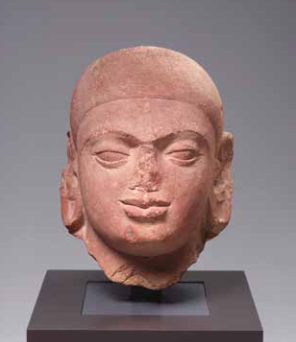
Figure 1. Head of a Tīrthaṃkara
India, Mathura, 1st or 2nd century
Sandstone, 33.5 x 23 cm
Museum Rietberg Zürich, RVI 2
Gift Eduard von der Heydt
Image © Rainer Wolfsberger, Museum Rietberg
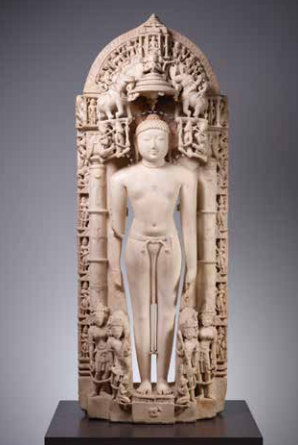
Figure 2. Ṛṣabhanātha
India, Rajasthan, Chandravati, 11th or 12th century
Marble, 161 x 57 x 25 cm
Museum Rietberg Zürich, RVI 213
Gift Eduard von der Heydt
Image © Rainer Wolfsberger, Museum Rietberg
There was a major change in 1972, when Eberhard Fischer became Director of the Museum Rietberg. Fischer was especially interested in Jain art. In 1974 he and his colleague Jyotindra Jain curated an exhibitionon the art and religion of the Jains.[4] They also published a book on Jain iconography.[5] Over the years Fischer continued to expand the Museum's collection of Jain art with a focus on Jain paintings. Today the Museum holds almost two hundred pieces of Jain art, comprising paintings and embroideries (Figures 3 and 4), sculptures and ritual objects.[6]
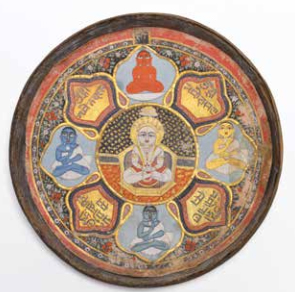
Figure 3. Siddhacakra
India, Rajasthan, late 18th century
Pigments, copper, diameter 12 cm
Museum Rietberg, RVI 916
Gift Barbara and Eberhard Fischer
Image © Rainer Wolfsberger, Museum Rietberg

Figure 4. Pārśvanātha resisting attacks depicted on a choṛ
India, Gujarat, frst half 20th century
Embroidery, 140 x 78 cm
Museum Rietberg Zürich, 2012.104
Gift Barbara and Eberhard Fischer
Image © Rainer Wolfsberger, Museum Rietberg
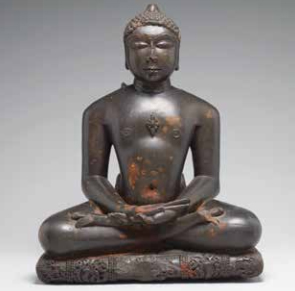
Figure 5. Tīrthaṃkara
India, Rajasthan, dated 1295
Stone, 66 x 55 x 20 cm
Museum Rietberg Zürich, 2016.35
Gift Melitta Schachner and Iso Camartin
Image © Rainer Wolfsberger, Museum Rietberg
As the Museum Rietberg plans a new exhibition on Jain art in the next couple of years, it has started to expand its collection of Jain objects. In 2016 a stone Jina was donated by Melitta Schachner and Iso Camartin (Figure 5). Unfortunately the inscription is unclear and iconographic markers are missing, so we cannot say who is depicted. However, the inscription refers to the year 1295 and mentions the donor Muni Shanta Rudra.
Also of note are some new acquisitions from the Kaufmann collection in Vienna. These include a group of six Jain bronzes, with images of Ṛṣabha and Mahāvīra among them (Figure 6). Also of particularly interest is a sculpture which can be identified through its inscription at the back as the third Jina, Sambhavanātha. (Figure 7). The peculiarity here is that there are two distinct inscriptions from two different hands at the back of the image. The one in smaller script has a date, but it is hardly legible. It is suspected that this inscription might have been written at a later stage and may not be authentic. The other inscription, on the other hand, conforms to a general pattern and does not arouse suspicion. The language is Sanskrit and the script is Jain Devanāgarī, a variety of Nāgarī used among Jains in Western India. The inscription is not clear, but from the discernible information we know the following: In 1491 CE (1548 of the Vikrama era) in Maṇḍapadurga, identified with modern Mandu in Madhya Pradesh, the image of Sambhavanātha (śrī Saṃbhavanāthabiṃbaṃ) was commissioned (kāritam) by a pious Jain laywoman named Padamāī. She was the wife of one Amarā who was the third son of the couple Moghara (not sure) and his wife Ramāī. The family belonged to one of the main Jain castes known as Śrīmāla. At the end it is said that the image was installed (pratiṣṭhitaṃ) by a Jain monk (sūriṇā), whose name is not legible.
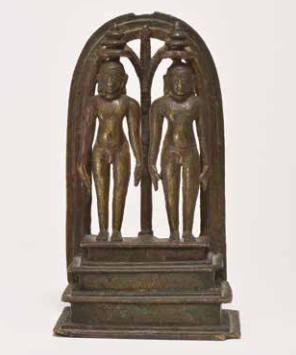
Figure 6. Ṛṣabha and Mahāvīra
India, 15th century
Copper alloy, 18 x 10.5 x 7 cm
Museum Rietberg Zürich, 2016.58
Purchase: Ganesha-Foundation
Image © Rainer Wolfsberger, Museum Rietberg
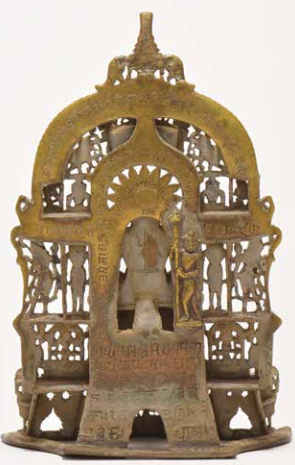
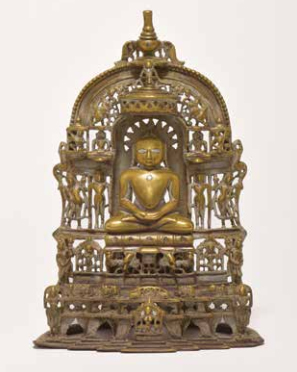
Figure 7. Sambhavanātha
India, 15th Century (V.S. 1548)
Copper alloy, 27 x 10 x 9 cm
Museum Rietberg Zürich, 2016.56
Purchase: Rietberg-Kreis
Image © Rainer Wolfsberger, Museum Rietberg
All new acquisitions are published in the online museum database, which for the time being is only accessible in German.[7] Ultimately these works of Jain art are not only an important new addition to the Museum Rietberg's existing collection, but a perfect prelude to the upcoming Jain exhibition.
Nalini Balbir is Professor of Indology at SorbonneNouvelle University, Paris and member of UMR 7528 «Mondes iranien et indien»; Johannes Beltz is Deputy Director, Head of Collections and Art Education, Curator of South and Southeast Asian Art, Museum Rietberg, Zurich.
See J.E. van Lohuizen-de Leeuw, Indische Skulpturen der Sammlung Eduard von der Heydt, Zürich: Museum Rietberg, (1964), pp. 2224, Fig 1; Härtel, H., Indische Skulpturen, Band 1, Berlin, 1960, Fig 11; H. Härtel, J. Irwin & R. Skelton, Indische Kunst, Stuttgart: Würtembergischer Kunstverein/ Museum für Kunst und Gewerbe Hamburg: Dr. Cantzsche Druckerei, 1966, Abb. Kat. Nr. 43, p. 1.
See J.E. van Lohuizen-de Leeuw, Indische Skulpturen der Sammlung Eduard von der Heydt, pp. 110-117.
See for example Karl With, Bildwerke Ost- und Südasiens aus der Sammlung Yi Yuan, Basel: Benno Schwabe & Co., 1924, Fig 90-93; W. Cohn, Asiatische Plastik, China, Japan, Vorder-, Hinterindien, Java: Sammlung Eduard von der Heydt, Berlin: Bruno Cassierer, 1932, p. 127-31; H. Härtel, J. Irwin and R. Skelton, Indische Kunst, Hrsg. von Würtembergischer Kunstverein Stuttgart, Museum für Kunst und Gewerbe Hamburg, Stuttgart: Dr. Cantzsche Druckerei, 1966, Fig. 91, p. 31; Phyllis Granoff (ed.), Victorious Ones, Jain Images of Perfection, New York: Rubin Museum of Art 2009, p. 110.
E. Fischer and J. Jain, Kunst und Religion in Indien: 2500 Jahre Jainismus, Wien: Museum für Völkerkunde, 1976.
 Prof. Dr. Nalini Balbir
Prof. Dr. Nalini Balbir